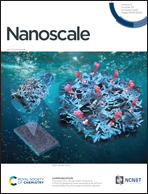FeCl2 monolayer on HOPG: art of growth and momentum filtering effect
Abstract
Magnetic layered transition metal halides have received intensive attention due to the potential magnetic properties in their monolayers. Following the recently reported success of trihalide monolayer ferromagnets, we have achieved the growth of a dihalide, FeCl2, monolayer system on graphite by molecular beam epitaxy. Scanning tunneling microscopy was used in the topographic and spectroscopic study of the monolayer islands at the atomic scale. Results show that the FeCl2 monolayer is an electronvolt-gaped insulator with various twist angles relative to the substrate. The tunneling probability on the monolayer islands is a function of the twist angle with a max/min ratio of ∼2.5. Our direct experimental evidence finds that the FeCl2 monolayer is an efficient momentum, perhaps spin, filtering insulating layer with subnanometer thickness.



 Please wait while we load your content...
Please wait while we load your content...